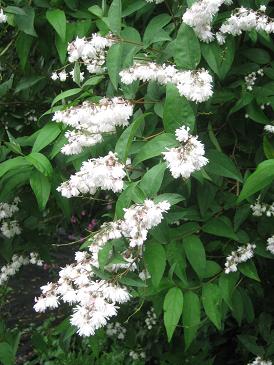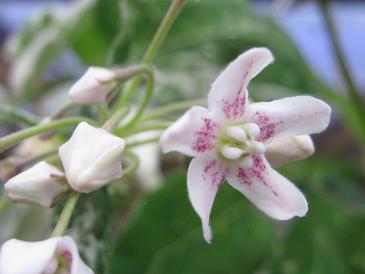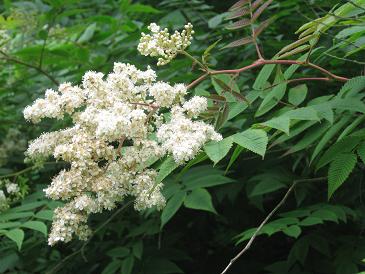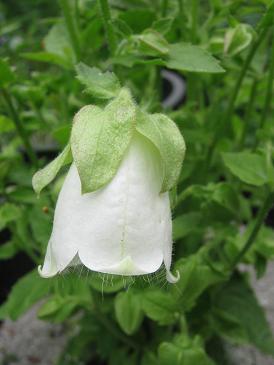JEARRARD'S HERBAL
Thats enough introduction - on with the plants!
To navigate this site, use the links above, or the detailed links at the bottom of this page.
... out in the garden.
19th June 2011

Deutzia 'Pride of Rochester'
It has been a wet week, and quite delightful. Once again the dry spring has broken in early summer. If it follows the pattern of the last five years, then we will
have a summer of sunshine and showers.Perhaps that isn't big news. Everything I have planted out lately has been thoroughly soaked and water tanks are full to capacity.
Who would have thought that my hair would be a living analogy for the spectre of drought?
Receding!
Years ago I found myself with a straggle of shrubs in pots (that is the collective term once the pots become scattered). In the spirit of 'do-or-die' I planted them
in the garden and some of them survived. At the time there were labels but they have long ceased to be legible. So now I have a mix of rather randon
shrubs around the garden and nothing but a failing memory and Google to identify them.
This seems to be Deutzia 'Pride of Rochester' though I am open to correction. I haven't been very interested in medium sized shrubs for a long time, but the
garden is beginning to need some middle sized structure and it is quite fun revisiting old territory and clearing out the cobwebs. There are a selection of
Deutzia and Philadelphus about the place still, and it will be interesting to try and identify them. I have two double Deutzia in flower at the
moment. This one with very pale pink on the outside of the outer petals, and another that is pure white and might be Deutzia scabra 'Plena'
or 'Candidissima'.
19th June 2011
 Dregea sinensis 'Variegata'
Dregea sinensis 'Variegata'
This is a pretty little climber, though not a great beauty. When I first got to know it the name was Wattakaka and it was in the Asclepiadaceae,
which made it the hardiest of the Hoya relatives. It was an oddity and that was what first attracted my attention. Since then it has become Dregea
and moved to the Apocynaceae, but it is still an odd "Hoya".
I was really pleased to come across the variegated form. I had seen it in books from Japan, but never in person. The leaves are mottled with white.
It seems to be cold hardy, though I am not sure about it's survival outside. It seems to like higher temperatures and drier winters than I can easily manage.
If it behaves like the green leaved form, then it will be easy to root from cuttings and rather vigorous in the greenhouse.
19th June 2011

Sorbaria arborea
Another from the straggle of pots. It sulked for years in a pot while I prevaricated about finding a place where it wouldn't be swallowed up by Brambles.
Little did I know. I planted it by the front entrance and before long I will have to make a second serious effort to remove it. I tried a few years ago, but didn't
manage to slow it up. It suckers with enthusiasm, and the canes root where they fall to the ground, so it can advance at a significant rate. It could stay where it is,
but it has completely obscured access to my mains water supply. Last time the meter was read all I could see was a pair of boots sticking out on the ground.
Many years ago I found my mothers legs sticking out from a Berberis. She had crept in on her stomach to find something, and was unable to reverse.
The removal process was not very dignified, but she laughed about it (eventually).
Despite its thuggish intentions, I am rather fond of the species. When it is removed I will find a more suitable location for a piece so that I can enjoy it
without fear.
19th June 2011

Symphyandra pendula
The herbaceous border needs a bit of weeding, and a thorough soaking will not have heped the situation, but plants are doing well and there are some surprises.
I planted this last autumn because I was a long time since I had grown it. It is one of the odd Campanula relatives and I was expecting it to disappear
through the winter - they don't generally like the moisture or the slugs in my garden.
It was a surprise to see this first flower open. It is a short lived perennial, but well known for flowering itself to death in the second season.
Easily raised from seed, if that is the way it chooses to behave, I will let it.
To find particular groups of plants I grow, click on the genus name in the table above. Click on the "Index" box at the top of the page for the full list.
I have a lot of good intentions when it comes to updating this site, and I try to keep a note
about what is going on, if you are interested.
If you want to contact me, the address is infoMONKEYjohnjearrard.co.uk
When typing the address in, please replace MONKEY with the more traditional @ symbol! I apologise for the tiresome performance involved, but I am getting too much
spam from automated systems as a result of having an address on the front page.

 Dregea sinensis 'Variegata'
Dregea sinensis 'Variegata' 
